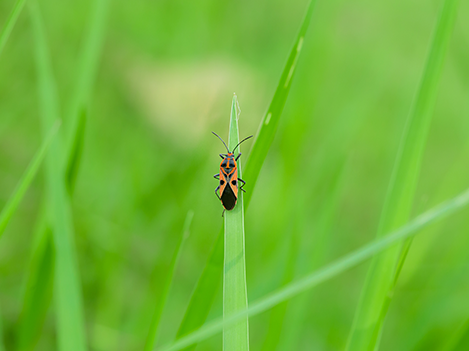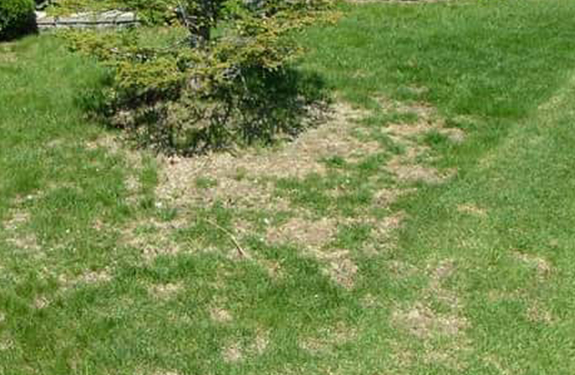Your Cart

Chinch Bug Management
Managing Chinch Bugs in Your Lawn
Are you consistently watering your lawn, yet it still appears dry? Does your lawn have irregular yellow patches or brown spots? You may be dealing with a chinch bug infestation.
WHAT ARE CHINCH BUGS?
Chinch bugs are small insects that live in and feed on lawn grasses. They live above the soil and feed on living grass plants by means of a piercing mouthpart called a stylet (similar to a mosquito). The insect inserts its stylet into the leaves, stems, or crowns of the lawn grasses and sucks the juices out of the plant.

Chinch bugs have a gradual life cycle with three stages: egg, nymph, and adult.
Chinch bug eggs are white in color, though they turn orange just before hatching. The eggs are bean-shaped, with one blunt end and one pointed end.
When the eggs have hatched, the chinch bugs enter the nymphal stage. There are five nymphal instars within this stage, all of which vary in appearance. In the first instar, the nymphs have an orange body with a cream-colored stripe, along with a brown head and thorax. In the second instar through to the fourth instar, the orange colour turns to a purple or grey colour with two black spots, and the nymphs slowly increase in size. In the fifth and final instar, the nymph turns black and wing pads become visible, as the length of the nymph grows to 3 millimeters.
In the adult stage, chinch bugs grow to be about 3.5 millimeters long and 1.75 millimeters wide. The majority of the body is grey or black and covered in hairs, aside from their wings that are white with a black spot in between, and their legs that are dark orange in color. Adult chinch bugs become active when daytime temperatures reach 70 degrees Fahrenheit, or 21 degrees Celsius. In the springtime, the female chinch bugs will lay up to 200 eggs within the folds of the grass blades or into the thatch. Eggs can hatch in as little as one week.
WHAT DOES CHINCH BUG DAMAGE LOOK LIKE?
Chinch bug damage looks quite similar to drought symptoms: dry, yellow or brown patches. Unlike with periods of drought, however, watering will not remedy the damage caused by chinch bugs.

HOW DO I TREAT FOR CHINCH BUGS?
Leaving chinch bug damage undiagnosed for too long can lead to complete turf destruction in a matter of weeks, meaning expensive and unexpected lawn repairs in your future. Promptly treating chinch bug infestations can help protect the investment you have made in a lawn care program and your property.
If you notice suspicious yellow or brown patches in your lawn, call your local Weed Man professional for a free healthy lawn analysis. We can verify the presence of a potentially damaging infestation, discuss preventative measures, and recommend treatment if required. Consult with your local Weed Man professional to discuss all options with respect to dealing with insects in your lawn.
Postal Code
- S0K
- S0M
- S7B
- S7H
- S7J
- S7K
- S7L
- S7M
- S7N
- S7P
- S7R
- S7S
- S7T
- S7V
- S7W
 English (CANADA)
English (CANADA)